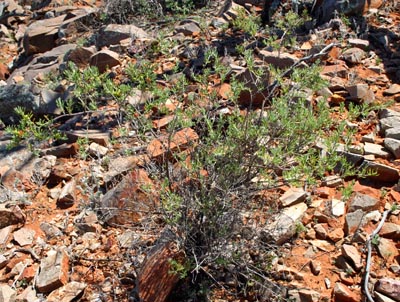


 |
 |
|
|||||
 |
|||||||
| |
|
|
|
|
|
||
|
|
|
|
|
|
|
|
|
|
Enchylaena
tomentosa
ruby saltbush The ruby saltbush is one of the large group of Chenopods found throughout Fowlers Gap and indeed Australia. The ruby saltbush is relatively rare on Fowlers Gap, and has only been observed on the stony ridges that make up the central part of the Station, overlooking Lake Bancannia to the east. Ruby saltbushes are spreading decumbent
shrubs less than 1 m high. The fruits are edible, but don't seem to be
of any nutritional benefit. Charles Sturt's expedition consumed the fruits
of the ruby saltbush but still suffered from scurvy (a vitamin C deficiency
disease), proving that the fruits did NOT contain vitamin C as they were
so believed. They would have been better off eating quandongs. |
  |